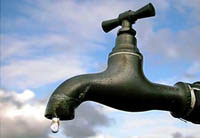
Yet even after the current drought ends, the West will continue to suffer water shortages thanks to population growth, economic development and the effects of climate change. When engineers designed the water infrastructure in arid states in the West, they assumed that future droughts and floods would follow historical patterns. But precipitation patterns have changed.
Traditional solutions—diverting more water from rivers, building new reservoirs or drilling additional groundwater wells—are no longer ways to substantially increase the water supply. In a new report for The Hamilton Project at the Brookings Institution, we, along with co-author Peter W. Culp, propose that states use market tools to promote water trading. That is, farmers or other users who reduce their consumption should be allowed to lease or sell the conserved water.
A major overhaul of Western water law is overdue, but implementing such reform would take years. In the near term, states should authorize short-term leases of water, build basic market institutions, deploy risk-mitigation tools such as dry-year options, and implement basic controls such as regulating how much water can be pumped. The current absence of viable market opportunities and incentives is producing perverse results.
In 2014 the worst drought in memory caused California farmers to fallow almost 500,000 acres of land, including some that produced high-value fruit and nut trees. Meanwhile, Western growers of alfalfa—a low-value and high-water-use crop—are on pace this year to export two million tons of alfalfa to China, South Korea and Japan—produced with enough water to supply several million U.S. families for a year or to irrigate hundreds of thousands of acres of high-value almond trees. If there were ways to trade water, some farmers could cut back on the production of more water-intensive, lower-value crops and lease or sell the conserved water to desperate fruit and nut growers or thirsty cities.
Most farmers don’t have that option. Even though federal and state policy fosters the export of agricultural commodities, Western water law generally inhibits trade in the water used to grow the commodities. States should open up the market by eliminating or streamlining legal barriers that effectively block transfers of water.
A market in water would encourage efficiency by stimulating innovation, promoting specialization and allowing water to move from lower-value to higher-value uses. Farmers who have an opportunity to trade a portion of their water have an incentive to take measures, such as installing more efficient irrigation systems, to free up water for trade. It would also create opportunities to deploy market-based tools, such as dry-year options, to help mitigate water risks to farms and cities.
For example, under a dry-year option, a water user with a low tolerance for water shortages—such as an almond farmer whose trees would quickly die without water—can contract with a seasonal agricultural user, such as a broccoli grower. In dry years, the almond producer would have the right to use the broccoli grower’s water. The almond producer pays a yearly premium to guard against times when water shortages would result in the loss of his orchard. The proceeds from the option give the broccoli grower a guaranteed revenue stream and thereby provide a hedge against a drought that might destroy his annual crop—mitigating risk for both parties.
The U.S. has a national interest in encouraging more efficient use of water everywhere. While Americans used to fret about running out of oil, water also fuels the American economy. A 2013 survey of the world’s largest companies by Deloitte Consulting found that 70% of respondents identified water as a substantial business risk, either in direct operations or supply chains. Companies with water challenges include obvious ones, such as Coca-Cola , and surprising ones, such as Intel, which needs large quantities of water to produce its processors.
The Western water crisis is basically an imbalance between supply and demand. Opening water resources to trade has the potential to reduce the imbalance by rewarding water conservation, ensuring that water goes toward the highest-value and most-efficient uses, and providing the financial tools to mitigate fluctuations in water availability.
Originally appeared in the Wall Street Journal on October 24, 2014.
Mr. Glennon, a law professor at the University of Arizona, is the author, most recently, of “Unquenchable: America’s Water Crisis and What to Do about It” (Island Press, 2009). Mr. Libecap, a professor at the University of California at Santa Barbara’s Bren School of Environmental Science and Management, is a PERC senior fellow and co-author with Terry L. Anderson of “Environmental Markets: A Property Rights Approach” (Cambridge University Press, 2014).



